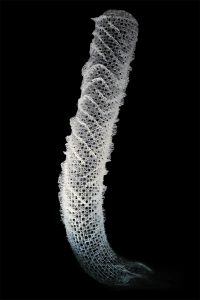 Sir Richard Owen is famous for coining the term “dinosaur” in 1842. But as a biologist, he made a number of scientific contributions. Just a year earlier he wrote about the intricate skeleton of a new sea sponge species found near the Philippines, calling it “a delicate cornucopia.” It was woven from “stiff, glistening, elastic threads, resembling the finest hairs of spun glass.” This sponge, known as Venus’ Flower Basket, remains fixed to the sea floor with nothing more than an array of thin, hair-like anchors that are essentially glass (see the pic). Researchers continue be amazed at how flexible this structure is since it is made out of silica. We don’t ordinarily think of glass as being “bendy.” But obviously there is a significant advantage for the sponge to have an anchor that is both strong and flexible. If it shattered on impact, it wouldn’t be terribly useful! Glass sponges can live thousands of years, placing them among the longest-lived creatures on Earth. They also have the ability to channel light through these silica strands in a manner similar to fiber optics. For the last two decades, a group of biologists, materials scientists and engineers at Harvard University have focused on the feature of Venus’ Flower Basket that attracted Owen: the intricate design of its glass skeleton. It is exceptionally strong — nearly as uncrushable as possible for this kind of structure. Dhruv Bhate of Arizona State University declared, “It’s sort of the holy grail of engineering design.” These researchers are now pursuing a patent for the sponge-inspired lattice. Adding more strength to architectural structures without adding more weight could theoretically allow for longer bridges, improved cranes and even better space rockets.
Sir Richard Owen is famous for coining the term “dinosaur” in 1842. But as a biologist, he made a number of scientific contributions. Just a year earlier he wrote about the intricate skeleton of a new sea sponge species found near the Philippines, calling it “a delicate cornucopia.” It was woven from “stiff, glistening, elastic threads, resembling the finest hairs of spun glass.” This sponge, known as Venus’ Flower Basket, remains fixed to the sea floor with nothing more than an array of thin, hair-like anchors that are essentially glass (see the pic). Researchers continue be amazed at how flexible this structure is since it is made out of silica. We don’t ordinarily think of glass as being “bendy.” But obviously there is a significant advantage for the sponge to have an anchor that is both strong and flexible. If it shattered on impact, it wouldn’t be terribly useful! Glass sponges can live thousands of years, placing them among the longest-lived creatures on Earth. They also have the ability to channel light through these silica strands in a manner similar to fiber optics. For the last two decades, a group of biologists, materials scientists and engineers at Harvard University have focused on the feature of Venus’ Flower Basket that attracted Owen: the intricate design of its glass skeleton. It is exceptionally strong — nearly as uncrushable as possible for this kind of structure. Dhruv Bhate of Arizona State University declared, “It’s sort of the holy grail of engineering design.” These researchers are now pursuing a patent for the sponge-inspired lattice. Adding more strength to architectural structures without adding more weight could theoretically allow for longer bridges, improved cranes and even better space rockets.
The Amazing Glass Sponge


